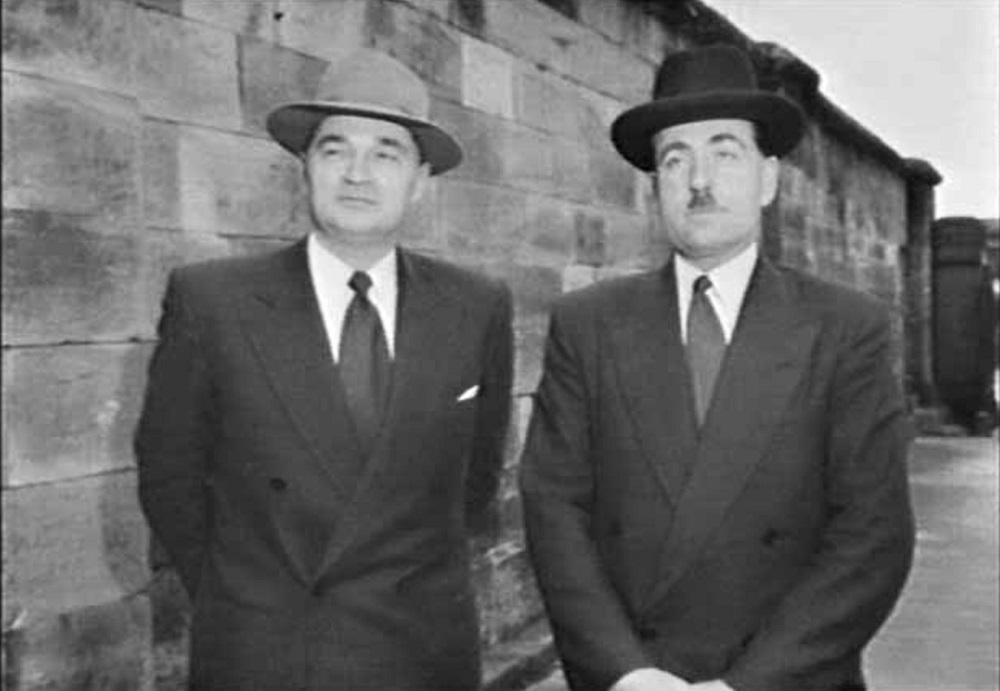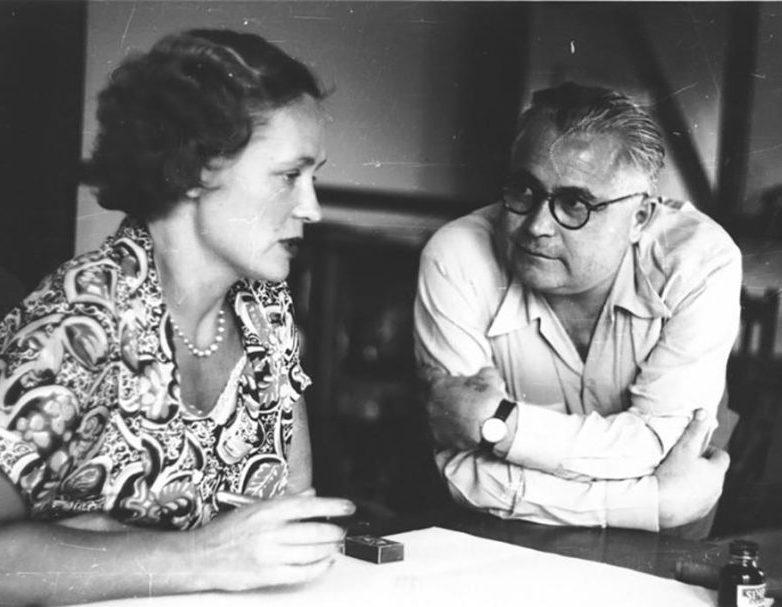Seventy-five years of history behind ASIO director-general’s threat assessment
Posted By Rhys Crawley on March 4, 2024 @ 10:52

Dressed in a suit, tie and knee-length overcoat [1], ASIO’s 43-year-old second director-general, Charles Spry [2], walked with his deputy straight past the press photographers and into Canberra’s Albert Hall for the first sitting day of the Royal Commission on Espionage. It was 18 May 1954, barely a month since the granting of political asylum to Soviet intelligence officers, Vladimir and Evdokia Petrov. Even in this, ASIO’s greatest triumph of the early Cold War, Spry refrained from giving statements or speaking to the media. His was a modus operandi of remaining mute.
Before the dramatic Petrov defections and the onset of spy fever, the Australian public knew little about ASIO or its elusive chief. ‘His careful clothes, his neat military moustache, his pleasant smile and soft voice seem almost out of keeping with the mystery which surrounds his work’, said The Sydney Morning Herald [3] of Spry. ‘Bland and unassuming, always more ready to listen than to talk, he gives the impression of an amiable professional man with no intellectual worries’. But Spry and the organisation he led quickly became household names. Readers of Adelaide’s The Mail [4] were told within weeks of Petrov’s defection that the ‘notably publicity-shy outfit’, established only five years earlier on 16 March 1949, ‘is emerging fleetingly from the shadows which usually mask its activities’.
Ordinarily, the commission’s findings [5] that the Soviet embassy, assisted by Australian communists, had engaged in espionage, would have been a boon for the fledgling security intelligence organisation. Professionally, Petrov had put ASIO on the map with its intelligence counterparts and opened new liaison channels in Europe and beyond. Yet, persistent claims by opposition leader Doc Evatt that Prime Minister Robert Menzies and Spry were in cahoots and engineered the defection to win the 1954 federal election, politicised ASIO and damaged for decades its reputation amongst large swathes of the Australian public. Rather than focus on the spies, as Spry would have preferred, much of the spotlight was uncomfortably being shone on the spy catchers.
So pervasive was distrust for ASIO amongst some politicians and segments of society, that a 1971 Australian Labor Party motion to abolish ASIO was defeated by only one vote. The Whitlam years brought other challenges for the nation’s domestic intelligence agency, including a ‘raid’ on its Melbourne headquarters by Attorney-General Lionel Murphy, and conspiracy theories including that ASIO was complicit in Whitlam’s dismissal. Along with the Petrov experience, these examples combined to ensure ASIO was hyper cautious about the possibility of politicisation.

This played out most spectacularly in 1983 when, on the eve of the federal election, its technical operation against KGB officer Valeriy Ivanov (Operation Bushfowl) uncovered him attempting to cultivate former ALP national secretary, David Combe. Conscious of the operation’s proximity to the election and acutely aware of earlier scandals, ASIO’s then director-general, Harvey Barnett, sat on the intelligence for weeks before informing the new Prime Minister, Bob Hawke, that the KGB was trying to recruit an ‘agent of influence’ with access to the government and senior ministers. Ivanov was promptly expelled, but, as John Blaxland and I wrote in The Secret Cold War [6], the Combe-Ivanov affair dominated ASIO’s relationship with the Hawke Government and thrust ASIO back into the spotlight. As Spry had in 1954, Barnett took the stand during the subsequent Royal Commission into Australia’s Security and Intelligence Agencies [7], stories of which appeared nightly in the news. With few exceptions, ASIO returned to its natural shadowy habitat and remained there for the next two and a half decades.
How things have changed.
The late David Irvine and his successor as ASIO director-general, Duncan Lewis, recognised the need to engage with the public and increase transparency. So, too, did some of their counterparts in other agencies. Notably, in 2012, the sixtieth year of ASIS, its director-general, Nick Warner, gave his service’s first public speech. His successor, Paul Symon, engaged audiences at book launches, on podcasts, in video interviews, and in a 2022 public address. The directors-general of ASD, Rachel Noble, and ONI, Andrew Shearer, have done likewise.
Last Wednesday, 28 February, ASIO’s 14th and current director-general, Mike Burgess, delivered another of his annual threat assessments. Alongside its yearly report to parliament and his frequent appearances at Senate Estimates, this assessment has become another—if not the—key means by which ASIO speaks to the public. As last week’s media coverage shows, its messages certainly reach a wide audience. Making expert use of his platform and social media, Burgess’ carefully phrased speech, each word deliberately chosen, was a welcome insight into ASIO’s functions and the threats it works to protect Australia against. Simultaneously revealing and vague, Burgess told us that espionage and foreign interference have surpassed terrorism as threats, and that sabotage is making a comeback.
The thing that struck me in Burgess’ speech, other than the shocking announcement that an Australian politician had been cultivated, recruited, and ‘sold out their country’, is how familiar were the threats.
Espionage, after all, was the reason for ASIO’s establishment. Countering sabotage, subversion and espionage defined the organisation’s work from the outset. Politically motivated violence and terrorism were later added to the list of tasks. Even if they are occurring ‘more … than ever before’, as we were told they are, there’s a real sense of ASIO’s history rhyming.
Burgess deliberately reached back into history, though more to remind us that it’s ASIO’s 75th year than to draw parallels to today. It was, nonetheless, fantastic to see him acknowledge Les Scott, Jack Griffiths and ‘Hilda Brooks’, each of whom I was privileged to interview about their long and varied careers. Amongst many other experiences, Les and Jack were members of the first dedicated large-scale ASIO surveillance team. Brought to Canberra from five different states, the Operation Wanderer team kept a close watch on the Soviet Embassy and concluded that Vladimir Petrov had more freedom than was usual for a diplomat of his rank. Operational efforts against Petrov became more targeted and focused as a result. In this, and countless other operations, Les and Jack saw up close the challenge of countering espionage and foreign interference. Both knew, and could have reminded us last week, that intelligence is not evidence. As watertight as a case might seem for intelligence purposes, that information might not be appropriate for a courtroom, either because it is incomplete or because its source needs protection. ‘Hilda Brooks’ could have explained the importance of protecting sources and methods better than anyone: for much of her career, Hilda was the person within ASIO most responsible for protecting the identify of ASIO agents.
In the Official History of ASIO, David Horner, John Blaxland and I traced its evolving efforts to counter espionage throughout the Cold War. Initially, as we saw with the Petrov case, it was an age of defections, where securing someone’s defection was the top prize. In time that emphasis shifted to expulsions, and thereafter to recruiting and running in place intelligence officers. Towards the end of the Cold War, ASIO took a pre-emptive approach, looking to deny visas to any diplomats with known or suspected intelligence links, so that they never set foot on Australian soil. Now, it appears, ASIO has entered an age of ‘intelligence-led disruption’ [8]. One thing is sure: ASIO’s own history provides some age-old lessons in operational approaches and tradecraft.
It might take the commissioning of another official history of ASIO series for us to ever know the finer details of the ‘A Team’ and ASIO’s activities against it. Similarly, until unfettered access to ASIO’s files is granted to future historians, we will probably have to accept that the only people who know all the details of the cases Burgess mentioned are himself and a select few senior officers. Seventy-five years of history tells us that’s unlikely to change. It’s business as usual for ASIO
Article printed from The Strategist: https://aspistrategist.ru
URL to article: /seventy-five-years-of-history-behind-asio-director-generals-threat-assessment/
URLs in this post:
[1] Dressed in a suit, tie and knee-length overcoat: https://trove.nla.gov.au/newspaper/article/27218365?searchTerm=spry%20petrov
[2] Charles Spry: https://adb.anu.edu.au/biography/spry-sir-charles-chambers-fowell-27317
[3] The Sydney Morning Herald: https://trove.nla.gov.au/newspaper/article/18420810?searchTerm=spry%20petrov
[4] The Mail: https://trove.nla.gov.au/newspaper/article/57952973?searchTerm=spry%20petrov
[5] findings: https://recordsearch.naa.gov.au/SearchNRetrieve/Interface/ViewImage.aspx?B=240948
[6] The Secret Cold War: https://www.allenandunwin.com/browse/book/John-Blaxland-and-Rhys-Crawley-Secret-Cold-War-AU0266-9781760297428
[7] Royal Commission into Australia’s Security and Intelligence Agencies: https://parlinfo.aph.gov.au/parlInfo/search/display/display.w3p;query=Id%3A%22chamber%2Fhansardr%2F1985-05-22%2F0059%22
[8] ‘intelligence-led disruption’: https://www.asio.gov.au/director-generals-annual-threat-assessment-2024
Click here to print.